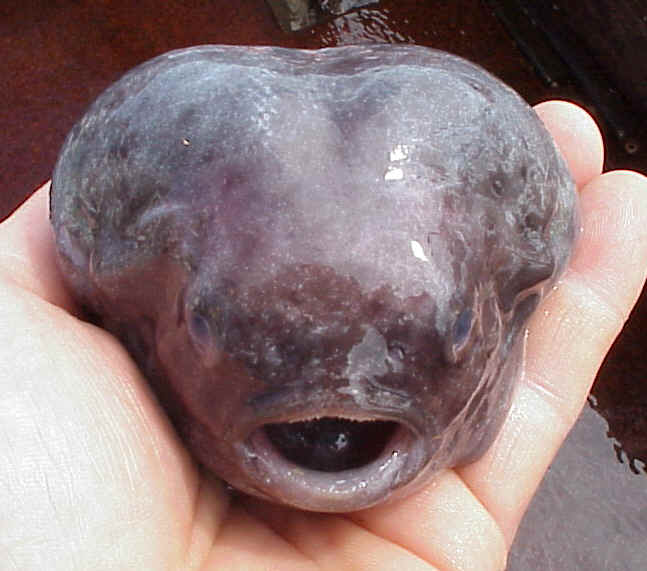|
| 질의: arctic cod | 결과: 14번째/18 | |
Lumpsucker (Family: Cyclopteridae) - Wiki
| 제목: | Lumpsucker (Family: Cyclopteridae) - Wiki
| |

| 해상도: 647x571
파일크기: 35186 Bytes
등록시간: 2007:12:17 11:25:45
|
Lumpsucker
From Wikipedia, the free encyclopedia
Scientific classification
Kingdom: Animalia
Phylum: Chordata
Class: Actinopterygii
Order: Scorpaeniformes
Family: Cyclopteridae
Genera: Aptocyclus, Cyclopsis, Cyclopteropsis, Cyclopterus, Eumicrotremus, Lethotremus
[Photo] Smooth Lumpsucker (Aptocyclus ventricosus), somewhat inflated as a defensive response. Image from NOAA's Alaska Fisheries Science Center (www.afsc.noaa.gov/race/media/photo_gallery/fish_files/Smooth_lumpsucker.htm).
Lumpsuckers or Lumpfish are mostly small scorpaeniform marine fish of the family Cyclopteridae. They are found in the cold waters of the Arctic, North Atlantic, and North Pacific oceans. The greatest number of species are found in the North Pacific.
The roe of larger species is used extensively in Danish cuisine, where the fish are known as stenbider. The roe is also used as a delicious and affordable alternative to the sometimes wildly expensive caviar.
The family name Cyclopteridae derives from the Greek words kyklos meaning "circle" and pteryx meaning "fin".
Physical description
Lumpsuckers are named appropriately enough; their portly bodies are nearly spherical with generally drab coloration and lithic patterns. The "sucker" part refers to the fish's modified pelvic fins, which have evolved into adhesive discs (located ventrally, behind the pectoral fins); the fish use these discs to adhere to the substrate. Many species have bony, wart-like tubercles adorning the head and body; these are important taxonomic features of the family.
The simple, rounded fins are small with the exception of the broad, fan-like pectorals, which actually extend ventrally. The first of the two dorsal fins is spinous, with 4-8 spines; in some species, this fin is completely overgrown with skin and therefore not visible. While the lateral line in Lumpsuckers is otherwise reduced or absent, it is well developed in the head; some species even have tubular, whisker-like external projections of the opercular canal, which is a part of the cranial lateral line system.
The relatively small mouths of Lumpsuckers are lined with narrow rows of small conical teeth. The gas bladder is absent. In terms of length, Lumpsuckers range in size from two centimetres in Lethotremus awae to 60 centimetres in Cyclopterus lumpus (known commonly as simply the Lumpsucker). With the exception of the Smooth Lumpsucker (Aptocyclus ventricosus) at 40.5 centimetres, all other species are under 14 centimetres in length.
Habitat and diet
As their appearance might suggest, Lumpsuckers are not good swimmers. Most species are benthic; that is, they spend most of their time on or near the bottom. The fish are found on rocky or muddy substrates, where their coloration allows for effective camouflage. Members of the family are found primarily on the continental shelf or slope, at depths from 100-1,700 metres. Some of the deeper-living species are however pelagic, remaining some distance above the ocean floor.
Benthic species dine upon sessile invertebrates such as polychaete worms, crustaceans and mollusks. Pelagic species target prey they are capable of overtaking, namely slow-moving jellyfish and ctenophores.
Behaviour and reproduction
Lumpsuckers are a poorly studied group, with little known of their behaviour and biology. At least some species are known to travel great distances in order to spawn in shallow, intertidal waters (from December to June in the Smooth Lumpsucker); this may well be true of all species. Males are also known to guard the brood of spherical eggs.
Hatchlings have well-developed pectoral fins and adhesive pelvic discs, which the fish use to cling to rocks in shallow water. Young fish remain in shallow, warmer water until fully developed. Pacific cod and Sablefish are known predators of Lumpsuckers, the latter capable of inflating themselves with water, presumably as a defensive tactic.
Species
There are 28 species in 6 genera:
Genus Aptocyclus
Smooth lumpsucker, Aptocyclus ventricosus (Pallas, 1769).
Genus Cyclopsis
Cyclopsis tentacularis Popov, 1930.
Genus Cyclopteropsis
Cyclopteropsis bergi Popov, 1929.
Cyclopteropsis brashnikowi (Schmidt, 1904).
Bumpy lumpsucker, Cyclopteropsis inarmatus Mednikov & Prokhorov, 1956.
Smooth lumpfish, Cyclopteropsis jordani Soldatov, 1929.
Cyclopteropsis lindbergi Soldatov, 1930.
Arctic lumpsucker, Cyclopteropsis mcalpini (Fowler, 1914).
Cyclopteropsis popovi Soldatov, 1929.
Genus Cyclopterus
Genus Eumicrotremus
Pimpled lumpsucker, Eumicrotremus andriashevi Perminov, 1936.
Eumicrotremus asperrimus (Tanaka, 1912).
Eumicrotremus barbatus (Lindberg & Legeza, 1955).
Leatherfin lumpsucker, Eumicrotremus derjugini Popov, 1926.
Eumicrotremus eggvinii Koefoed, 1956.
Eumicrotremus fedorovi Mandrytsa, 1991.
Eumicrotremus gyrinops (Garman, 1892).
Pacific spiny lumpsucker, Eumicrotremus orbis (G??nther, 1861).
Eumicrotremus pacificus Schmidt, 1904.
Toad lumpsucker, Eumicrotremus phrynoides Gilbert & Burke, 1912.
Eumicrotremus schmidti Lindberg & Legeza, 1955.
Eumicrotremus soldatovi Popov, 1930.
Atlantic spiny lumpsucker, Eumicrotremus spinosus (Fabricius, 1776).
Eumicrotremus taranetzi Perminov, 1936.
Eumicrotremus tartaricus Lindberg & Legeza, 1955.
Eumicrotremus terraenovae Myers & B??hlke, 1950.
Genus Lethotremus
Lethotremus awae Jordan & Snyder, 1902.
Lethotremus muticus Gilbert, 1896
http://en.wikipedia.org/wiki/Lumpsucker
| The text in this page is based on the copyrighted Wikipedia article shown in above URL. It is used under the GNU Free Documentation License. You may redistribute it, verbatim or modified, providing that you comply with the terms of the GFDL. |
|
^o^
동물그림창고 똑똑전화 누리집
^o^
|
|